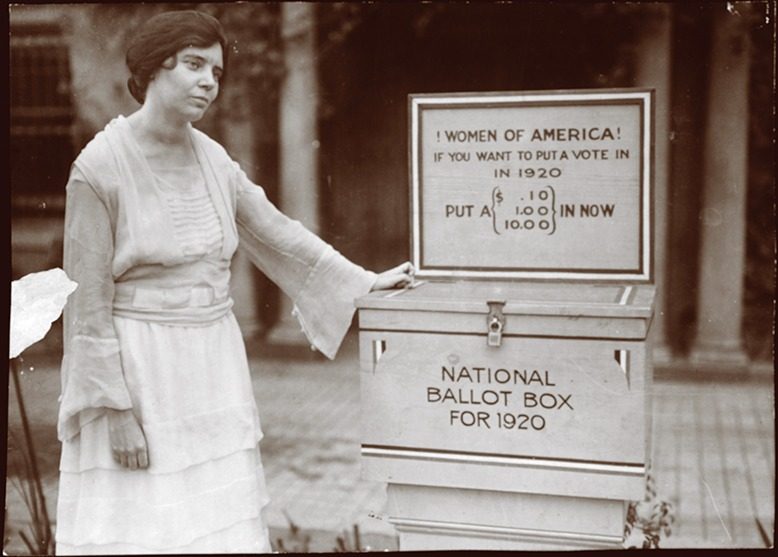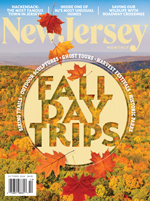
Raised in the bosom of her refined Quaker family, Mount Laurel’s renowned feminist, Alice Paul, steadfastly refused to resort to violence in her struggle for women’s rights.
Yet surely, this mightily determined woman had to resist the occasional urge to kick the shins of the seemingly endless stream of stubborn men, and even some women, who rejected her demand that women be allowed to vote.
On the other hand, Paul’s foes had no qualms about using violence against her. Forced feedings during her multiple imprisonments in the United States and England caused permanent damage to her esophagus and heart. On numerous occasions, while picketing at the White House, Paul was viciously attacked by angry mobs.
Nevertheless, she persisted—and her efforts, joined with millions of activists across the nation, paid off on August 18, 1920, when the 19th Amendment to the Constitution was ratified, granting women the right to vote.
Paul was one of more than 70 brilliant, dogged and often disgusted Garden State women (and the occasional sympathetic man) who played leading roles in the drama.
[RELATED: A Guide to Events Celebrating the Centennial of Women’s Suffrage]
Surprisingly, the 19th Amendment did not mark the first time American women were allowed to vote. In fact, New Jersey led the way almost 150 years earlier, points out Jean Sinzdak, associate director of the Center for American Women and Politics at the Eagleton Institute of Politics at Rutgers-New Brunswick.
Back in 1776, New Jersey’s first state constitution permitted suffrage for female property holders—as well as free blacks, both female and male—according to women’s suffrage expert Erin M. Andersen, assistant professor at Centenary University, where she directs the Writing Collaboratory. That freedom lasted a mere 31 years, until 1807, when New Jersey’s all-male state Assembly limited voting rights to free white males.
Appalled by that arbitrary act, New Jersey women vowed not only to regain the vote in their own state, but to take it a step further, joining suffragists throughout the nation to win universal voting rights.
Things heated up in 1848 when, in upstate New York, Elizabeth Cady Stanton, Lucretia Mott and three other women organized the nation’s first women’s rights convention at Seneca Falls. The event launched the women’s suffrage movement.
[RELATED: Jersey’s History of Voices for Women’s Rights]
Stanton lived in Seneca Falls at the time, but for 19 years, from 1868–1887, Stanton, her lawyer husband Henry, and their seven children lived in a mansion in Tenafly, where, according to the late historian Kevin W. Wright, she accomplished some of her most important work on women’s suffrage. Stanton’s Tenafly home “became a gathering place for many leading reformers seeking social and economic equality for women,” Wright reported in a Bergen County Historical Society article.
The same year that Stanton moved to Tenafly, she and her friend, Susan B. Anthony, launched their women’s rights newspaper, Revolution. The following year, the two cofounded the National Woman Suffrage Association. Stanton served as president from 1890–1892.
Stanton wrote many of Anthony’s eloquently delivered speeches over the years. During Stanton’s residency in Tenafly, she and Anthony also worked on their three volumes of the History of Woman Suffrage.
* * *
Stanton and Massachusetts-born Anthony were the two great icons of the suffragist movement at the turn of the 20th century. But their deaths—Stanton’s in 1902 and Anthony’s in 1906—left the national movement to languish. Into the breach stepped Alice Paul.
Paul was born in 1885 in a stately Mount Laurel farmhouse. Her mother, Tacie Parry Paul, took Alice—the firstborn of her four children—to women’s suffrage meetings. Always a superachiever, Alice was class valedictorian at Moorestown Friends High School. She would go on to earn a bachelor’s degree and five post-graduate degrees, including doctorates in law and sociology. During a trip to England in 1908 to study at the London School of Economics, she met militant British suffragettes (as U.K. suffragists were known) Emmeline Pankhurst and her daughter, Christabel.
Paul brought to the U.S. movement the peaceful tactics taught to her by the Pankhursts, says Lucienne Beard, executive director of the Alice Paul Institute at Paulsdale, Paul’s birthplace in Mount Laurel.
But first, Paul honed her acts of civil disobedience in England, where she was arrested seven times and imprisoned thrice on trumped-up charges such as disturbing the peace. During one monthlong confinement in England’s Holloway Prison, she went on a hunger strike in an attempt to gain early release and earn public sympathy for the cause.
In rare clips from a December 9, 1908, London newspaper and the January 22, 1909, Philadelphia Tribune, both now stored at the Library of Congress, Paul vividly described her treatment by her English jailers. In the Tribune, she stated that, twice a day, “I was forced into a chair, bound with sheets, and sat upon bodily by a fat murderess whose duty it was to keep me still. Then the prison doctor, assisted by two women attendants, placed a rubber tube up my nostrils and pumped liquid food through it into the stomach.” So weak was Paul at the end of her incarceration that she had to be carried out and required immediate medical help for severe gastritis.
Returning to the United States in early 1910, she continued her activism and her education. Four years later, Paul came up with a new, nonviolent form of protest: picketing at the White House. Woodrow Wilson, who had been the Garden State’s governor from 1911–1913, was in his first term as president. He claimed to personally favor women’s suffrage, but insisted it was a state matter.
An amendment to give women the right to vote was first introduced to Congress in 1878. It failed for decades. Determined to finally get the amendment passed, suffragists sought Wilson’s support. On November 17, 1913—the same year Alice Paul founded the Congressional Union for Woman Suffrage, which later became the National Woman’s Party—she and 70 other New Jersey suffragists met with Wilson.
After that fruitless meeting, the New Jersey delegation marched on the U.S. Capitol to lobby the state’s representatives. New Jersey suffragists were plucky: “They even chased down New Jersey Senator William Hughes [who was riding in a car on Pennsylvania Avenue] with a parade of taxis,” The Washington Post reported.
Daily picketing at the White House by women from across the nation continued for years. A photo in the Library of Congress’s collection shows Morristown suffragist Alison Turnbull Hopkins as she picketed January 30, 1917, with more than 5,000 other suffragists on New Jersey Day at the White House.
Many suffragists also fought for the prohibition of alcohol—and earlier, for the abolition of slavery. “As their work progressed,” says Lucia McMahon, who chairs the history department at William Paterson University, “women often came to realize that, no matter what cause they were advocating for, their ability to influence public policy and legislation was limited without the vote.”
In March 1917, Paul was arrested at the White House gates on a charge of blocking traffic—even though the pickets had remained on the sidewalk. Numerous witnesses reported it was actually an unruly mob of anti-suffragists who blocked traffic. Paul was jailed in the District of Columbia for five weeks while more than 30 of her suffragist sisters were imprisoned in Virginia and, according to multiple accounts, savagely attacked and abused by their jailers.
Paul again refused to eat, and her jailers again force-fed her, upping the violent assaults to three times a day. Paul was one of the first American political activists to use a hunger strike as a weapon.
Finally, in 1918, moved in part by the prominent role women played in the effort to win World War I, Wilson endorsed their right to vote. The House of Representatives and Senate approved the amendment in 1919—on May 21 and June 4, respectively—and the requisite number of states at long last ratified the 19th Amendment on August 18, 1920. On August 26, Secretary of State Bainbridge Colby certified the amendment’s ratification, making women’s right to vote official.
Paul’s work to gain equal rights for women didn’t stop there. In 1923, she wrote the original Equal Rights Amendment. (Crystal Eastman, a cofounder of the American Civil Liberties Union, is sometimes credited as coauthor of the original ERA.) In 1938, Paul founded the World Woman’s Party, headquartered in Geneva, Switzerland. In 1943, when the ERA was rewritten, it was named the Alice Paul Amendment.
Fighting for the ERA became Paul’s passion. “Her five decades of work for an Equal Rights Amendment are what she considered her life’s work,” says Beard, of the Alice Paul Institute. “From her wheelchair in a Moorestown nursing home toward the end of her life, she continued to lobby state representatives to pass the ERA.” Paul died in 1977 at the age of 92.
Almost 100 years after it was introduced in Congress, the ERA has yet to be ratified—and the 19th Amendment remains the only mention of the word woman in the U.S. Constitution. Suffrage is the only right guaranteed to women under federal law.
* * *
Today, women outnumber men at the polls. Cindy Gordon, spokesperson for the Princeton Area League of Women Voters, cites a 2018 article from the Center for American Women and Politics at Rutgers, which reports that “women vote in higher numbers than men and have done so in every election since 1964.”
The article states that in 2016, 9.9 million more women than men voted. That year, 63.3 percent of eligible female adults went to the polls, compared to 59.3 percent of eligible male adults.
“If we want a government that works for all of us, we need to participate at all levels—the most basic of which is voting,” says Nancy Hedinger, president of the League of Women Voters of New Jersey. “When more women participate, the outcome will reflect their views on those issues that most impact them and their families.”
It appears women took the right to vote seriously from the start. Willingboro resident and longtime women’s rights activist Lilyan Cralle, 79, tells the story of her grandmother, Jennie Plaskow, taking advantage of her newly minted right to vote in the November 2, 1920, presidential election, the first following ratification of the 19th Amendment. The candidates, both from Ohio, were Republican senator Warren G. Harding and Democratic governor James M. Cox.
“As a farm wife living on Garton Road in Rosenhayn,” Cralle relates, “my grandmother hitched up the horse, Bessie, to the wagon and drove herself to vote. When she returned home from the polling place, my grandfather, Mordecai, asked her whom she had voted for. She replied, ‘That’s my business.’”
Cralle had the honor of meeting Paul twice in the 1970s, when Paul lived in the Greenleaf nursing home on Main Street in Moorestown. “When I first saw Alice Paul,” Cralle remembers, “she looked like so many other elderly women in nursing homes. Framed by a head of untamed white hair, she seemed frail, distant, lost in her thoughts, and way too tiny for the chair she sat in.
“However, as soon as someone in our group told her we had just been marching on Main Street in support of the ERA, she came alive and started telling us which legislators we needed to contact, what states were critical, and how we should go about getting the word out. The transformation was amazing! She became a general commanding the troops.”
Cralle even had a private moment with Paul. “At some point in one of our meetings,” she says, “her hands became sticky from something she was eating. I went into the adjoining bathroom and brought her a wet washcloth. She said, ‘Now there’s a practical woman.’ It is a memory I will always cherish.”
Barbara Leap, retired director of public information at Rutgers-Camden, was previously a reporter and feature writer for the Philadelphia Inquirer, Philadelphia Bulletin and Courier-Post.



